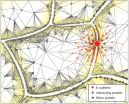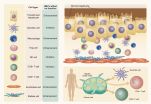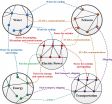INFORMATION:
The USDA supported this work.
People in unhappy places are depressed more than a week a month
2014-12-03
(Press-News.org) People in the country's unhappiest communities spend about a quarter of the month so far down in the dumps that it can harm their productivity, according to economists.
"This is a real concern not just in the United States, but across the world," said Stephan Goetz, professor of agricultural economics and regional economics, Penn State, and director of the Northeast Regional Center for Rural Development. "Poor mental health can result in considerable economic costs, including losses of billions of dollars to lower productivity and this doesn't even include the staggering personal costs of negative mental health and depression."
Residents in the community with the poorest mental health on average reported they spent 8.3 days a month in a negative mood. People in high mental health areas reported they were in poor mental health only a little less than half of a day each month, according to the researchers.
Goetz said that suburban residents seem to be the happiest, compared to those who live in rural areas and inner cities. After controlling for certain conditions, such as commute time, people who lived in suburbs tended to report the fewest poor mental health days, according to the researchers, who report their findings in the online version of Social Indicators Research. Places where people felt more connected with the community also reported fewer poor mental health days.
"People who live in the suburbs are closer to jobs and all of the amenities that a big city can provide, but they're also far enough away from the stress of the inner city," said Goetz. "It may be that you don't want to be too close to people, but you don't want to be too far away either."
Another important result was that people facing longer commutes experienced significantly more poor mental health days, regardless of whether they lived in a suburb, rural area, or inner city, according to Goetz.
Tighter knit communities also were happier, according to the study. People who live in communities with strong ties -- or high social capital -- have better general wellbeing and can rely on a network of support to help when stresses do arise.
"The more supported you are by the community, the happier you are, and the better you are able to cope with troubles," said Goetz, who worked with Meri Davlasheridze, assistant professor of marine sciences, Texas A&M and Yicheol Han, postdoctoral scholar in agricultural economics and regional economics, Penn State.
While the negative effects of income inequality are receiving more attention from economists lately, Goetz said that if community leaders are concerned with improving mental health, they should try to reduce poverty rather than attempt to manage income equality.
"When you live in poverty you might not care about how well-off your neighbors are, you just want to get out of poverty," said Goetz. "The research doesn't suggest that income equality doesn't matter, but it does indicate that the sting of actual poverty is far worse."
To gather information on poor mental health days, the researchers studied census data and information from the Behavioral Risk Factor Surveillance System, a telephone survey that includes information on how many days in a month participants would describe their mental health as poor. Because the recent economic downturn could skew the mental health figures, the researchers used information from 2002 to 2008, a period before the recession.
The researchers also used information from the Economic Research Service of the U.S. Department of Agriculture and the U.S. Census.
Future research may look at how improving the economic conditions and cohesion of a community could lead to more optimistic residents as an approach to curb drug and alcohol abuse in communities.
"As economists we talk a lot about financial costs, but often don't consider the high personal costs that are incurred in some of these communities, including those associated with drug abuse and crime," said Goetz. "It's gut wrenching to hear stories of how substance abuse has hurt people and destroyed families and we're eager to work with the Substance Abuse and Mental Health Services Administration of the Department of Health and Human Services to research the problem and find ways to help these communities."
ELSE PRESS RELEASES FROM THIS DATE:
Brain activity after smokers quit predicts chances of relapsing, Penn study suggests
2014-12-03
PHILADELPHIA--Quitting smoking sets off a series of changes in the brain that Penn Medicine researchers say may better identify smokers who will start smoking again--a prediction that goes above and beyond today's clinical or behavioral tools for assessing relapse risk.
Reporting in a new study published this week in the journal Neuropsychopharmacology, James Loughead, PhD, associate professor of Psychiatry, and Caryn Lerman, PhD, a professor of Psychiatry and director of Penn's Center for Interdisciplinary Research on Nicotine Addiction, found that smokers who relapsed ...
Human influence important factor in possible global and UK temperature records
2014-12-03
Recent research from the Met Office and the University of East Anglia (UEA) suggests breaking the existing global and UK temperature records is much more likely due to human influence on the climate.
Early Figures Suggest Global Record Possible
The global mean temperature for January to October based on the HadCRUT4 dataset (compiled by the Met Office and UEA's Climatic Research Unit) is 0.57 °C (+/- 0.1) above the long-term (1961-1990) average. This is consistent with the statement from the World Meteorological Organization (WMO) today.
With two months of data still ...
Mapping the interactome
2014-12-03
Researchers at the Mechanobiology Institute at the National University of Singapore have comprehensively described the network of proteins involved in cell-cell adhesions, or the cadherin interactome. This work was published in Science Signaling (Guo et al. E-cadherin interactome complexity and robustness resolved by quantitative proteomics, Science Signaling, 02 Dec 2014, Vol 7, Issue 354).
Unlocking the complexity of cell adhesion
Many biological processes depend on the ability of cells to stick to one another. The formation of multicellular organisms and precise ...
Gut bacteria from a worm can degrade plastic
2014-12-03
Plastic is well-known for sticking around in the environment for years without breaking down, contributing significantly to litter and landfills. But scientists have now discovered that bacteria from the guts of a worm known to munch on food packaging can degrade polyethylene, the most common plastic. Reported in the ACS journal Environmental Science & Technology, the finding could lead to new ways to help get rid of the otherwise persistent waste, the scientists say.
Jun Yang and colleagues point out that the global plastics industry churns out about 140 million tons ...
Tumor microenvironment of hepatitis B virus-associated hepatocellular carcinoma
2014-12-03
Hepatocellular carcinoma (HCC) is one of the few cancers in which a continued increase in incidence has been observed over recent years. Globally, there are approximately 750,000 new cases of liver cancer reported each year. Importantly, population-based studies show that HCC ranks as the third leading cause of cancer-related deaths worldwide. Also, a large proportion of HCC patients display symptoms of intrahepatic metastases or postsurgical recurrence, with a five-year survival rate of around only 30-40%.
Among the various pathogenic factors, HBV infection accounts ...
Novel approach to treating asthma: Neutralize the trigger
2014-12-03
Current asthma treatments can alleviate wheezing, coughing and other symptoms felt by millions of Americans every year, but they don't get to the root cause of the condition. Now, for the first time, scientists are reporting a new approach to defeating asthma by targeting the trigger -- the allergen -- before it can spark an attack. They describe their new compound, which they tested on rats, in ACS' Journal of Medicinal Chemistry.
Clive Robinson and colleagues explain that to prevent many health problems, the ideal approach to treatment or prevention involves getting ...
Scientists in China, US, Israel review the worldwide rise of the 'network of networks'
2014-12-03
The interdisciplinary field of network science has attracted enormous attention in the past 10 years, although most results have been obtained by analyzing isolated networks. However many real-world networks interact with and depend on other networks.
"The properties and dynamics of interdependent and interconnected networks have been studied extensively, and scientists are finding many interesting results and discovering many surprising phenomena," state scientists based in China, the US and Israel who co-authored a new study, "From a single network to a network of ...
Secondary relaxation in metallic glasses: A key to glassy materials and glassy physics
2014-12-03
Humans have been experimenting with and utilizing glassy materials for more than ten millennia, dating back to about 12000 B.C. Although glassy materials are the oldest known artificial materials, new discoveries and novel applications continue to appear.
Yet understanding of glass is far from complete, and the nature of glass constitutes a longstanding puzzle in condensed mater physics.
In a new overview titled "The β-Relaxation in Metallic Glasses" and published in the Beijing-based National Science Review, co-authors Hai Bin Yu and and Konrad Samwer, based at ...
How soil microorganisms get out of step through climate change
2014-12-03
In order to observe the impact of climate change on soil microorganisms under as natural conditions as possible, the scientists transferred intact young beech seedlings from a cool, wet, northwest-exposed site of a slope approximately corresponding to present climatic conditions to a warmer site exposed to the southwest. This transfer simulated temperature and precipitation profiles as can be expected from climate change. "We tried to keep initial soil type and nutrient content sin soil as comparable as possible to avoid additional factors influencing our data"," said Prof. ...
VTT: Demolition planning as part of construction
2014-12-03
With good planning, it is possible to promote the reuse of construction and demolition waste and thereby both conserve the environment and save on material costs. In the future, it will be even more important to assess how buildings can reasonably be repaired or demolished into parts, together with how the remaining service life of the parts can be utilized in new applications. The best method is to implement demolition planning already as a component of construction design.
Reuse of construction parts is always worthwhile from the perspective of the environment, and ...




